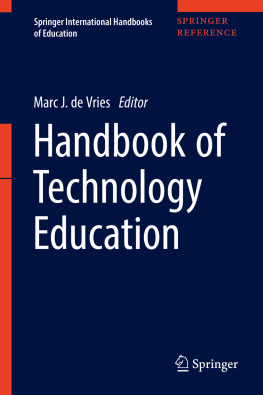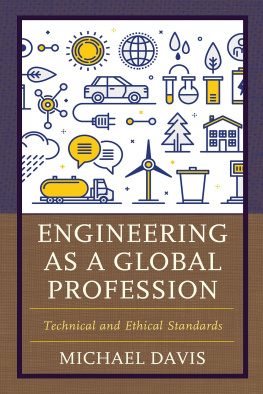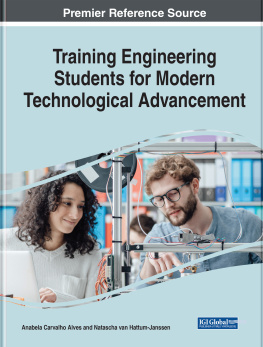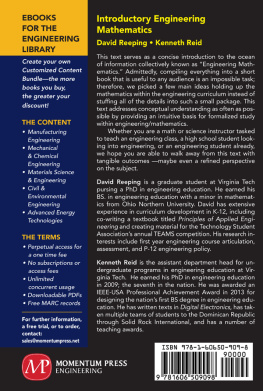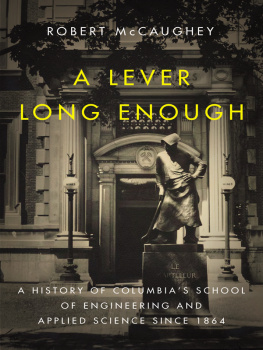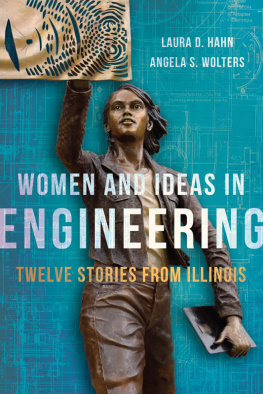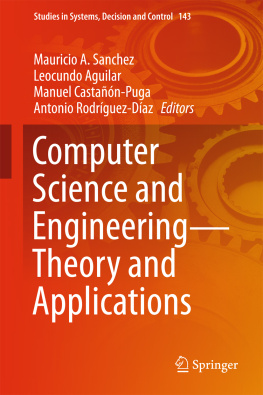MONICA E. CARDELLA
Copyright 2014 by Purdue University. All rights reserved.
Engineering in pre-college settings : synthesizing research, policy, and practices / edited by enay Purzer, Johannes Strobel, and Monica E. Cardella.
Includes bibliographical references and index.
ISBN 978-1-55753-691-4 (hardback : alk. paper)ISBN 978-1-61249-357-2 (epdf)ISBN 978-1-61249-358-9 (epub) 1. Engineering--Study and teaching. I. Purzer, Senay, 1976- II. Strobel, Johannes, 1974- III. Cardella, Monica E.
I have been involved for almost 15 years in projects related in one way or another to K-12 engineering education. Through my work at the National Academy of Engineering, I have come to know a great many engineers, engineering educators, K-12 educators, and education researchers. It is largely through these connections that I have developed an appreciation for the value of engineering habits of mind and for the opportunities engineering education can provide young learners by engaging them in activities that matter to them, their peers, families, communities, and the world at large. Although the potential value of K-12 engineering education is evident so, too, are the challenges. These range from macro issues of implementation at the level of schools, school districts, and states, to more micro concerns related to the delivery of instruction and the effective preparation of educators working both in classrooms and in free-choice learning environments.
Readers may fairly assume, given my affiliation, that I am an advocate of K-12 engineering education because I believe the United States needs to produce more engineers. Although there are some supporters of precollege engineering who do feel this way, I am not one of them. For one thing, there is virtually no evidence that K-12 engineering experiences directly cause students to enter college engineering programs. This is not to say such experiences cannot influence student attitudes and motivations regarding engineering. In addition, at the time of this writing, U.S. engineering enrollments are at their highest level in history. And data from the Bureau of Labor Statistics show that some 40 percent of individuals considered to be doing engineering work in the United States have degrees in disciplines other than engineering. Taken together, these facts suggest a value proposition for K-12 engineering education that goes beyond careers and the national imperative to sustain an innovation economy. To that end, I am an advocate of providing as many young people as possible opportunity to learn to think systematically, to identify and solve problems of significance, to accept failure as a part of their intellectual development, and to be comfortable in situations in which there are multiple possible outcomes. These traits describe engineering habits of mind but have potential utility in many areas of life beyond the practice of engineering.
The increasing use of the STEM acronym in public policy and education circles in the United States presents an opportunity, and some real dilemmas, for supporters of engineering education at the K-12 level. To the extent discussions of STEM can be turned toward the correctly point out that STEM integration is not new. This is more true for integration involving mathematics and science than it is for engineering, however, which has been a meaningful component of U.S. precollege education for only the last two decades or so. The Next Generation Science Standards, which weave engineering design and a few key engineering concepts into science content and practices, provide a new lever for integration efforts involving the S and E of STEM. (It is worth noting that the Common Core State Standards for Mathematics, which present the math education communitys current best thinking about the mathematical concepts and practices important for the development of K-12 students, provide very few overt opportunities for integration with other subject matter.) But as is made clear in several other chapters of this volume, doing integration well is not a trivial matter. A 2014 report from the National Academies on the topic of K-12 STEM integration points out that the practice will likely require new forms of professional development and teacher education; additional time for planning and collaboration among educators; and new ways of measuring student outcomes, among other challenges.
How proponents, practitioners, and even researchers of K-12 engineering education describe engineeringamong themselves and to othersmatters. It is particularly important that those who interact with students and parents use language that informs and engages. Stereotypes of the engineer as disconnected from the concerns of people and of engineering as principally involving the application of high-level mathematics and science have been a disservice to the profession and will be an impediment to the long-term success of K-12 engineering education. As the authors of note, there are various resources that model more effective messaging: engineering as a creative pursuit, engineering as something that makes a difference to people and the world, engineering as a force that helps shape the future. More can and should be done to fine tune the available messages for different populations and purposes. Ultimately, there needs to be a broad shift in the conversation about engineering, including but extending well beyond the education community. Technology-focused industry, the engineering professional societies, undergraduate engineering programs, and science and technology centers need to play a significant role in this effort.
I commend the editors of this volume for producing such a comprehensive presentation of the many important dimensions of K-12 engineering education. Far from being the last word on the topic, I hope these chapters stimulate discussion, induce collaborations, and promote much-needed research on this still new but very promising development in the U.S. education system.
In August 2011, a group of faculty and staff from Purdue University organized a summit on P12 engineering and design research funded by the Institute for P12 Engineering Research and Learning (INSPIRE). The main goal of this summit was to improve the quality and coherence of research in engineering education. At that point neither the framework for science education nor the Next Generation Science Standards had been publicized or finalized. The P12 Engineering and Design Education Research Summit (P12 Summit) achieved two goals. The summit (1) brought together a diverse range of stakeholders committed to engineering education, such as researchers, teachers, and professionals engaged in informal education, and (2) supported dialogue to assess the current state of P12 engineering education research and identify the needs of the engineering education research community. Many of the authors who contributed to this book attended that summit. Hence, this volume includes chapters that are written by a diverse group of scholars and educators, not just university faculty, who are at the frontiers of efforts in engineering education both in formal classroom and informal learning settings.



